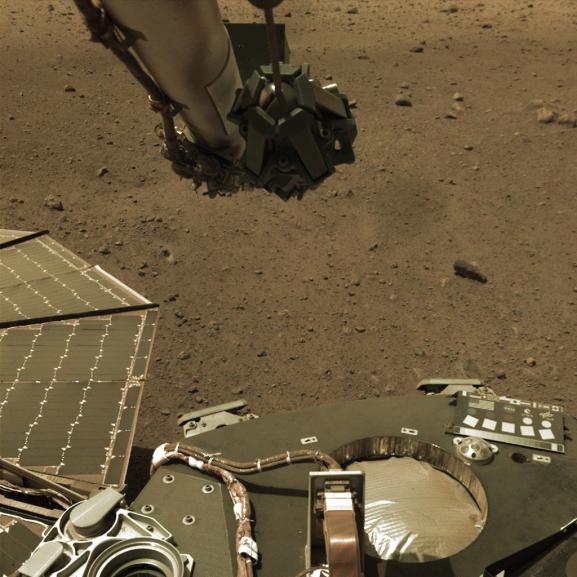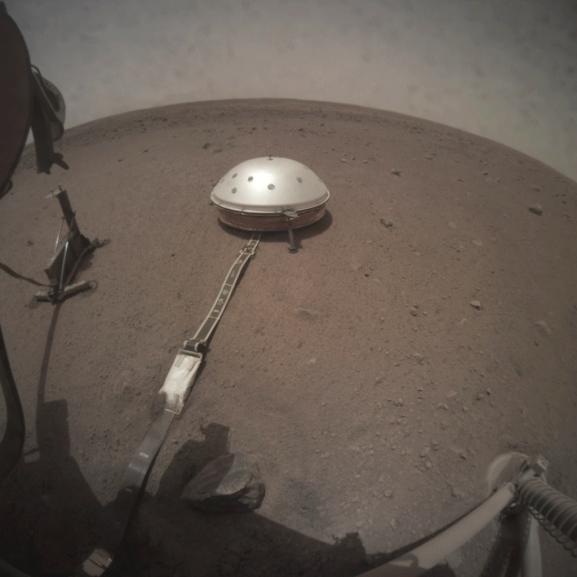Phobos' Shadow: Experience an Eclipse on Mars with NASA's InSight Lander
NASA's InSight Mars lander focuses its sensitive instruments on the Martian surface and below, but it took a moment to appreciate celestial events last week: two quick eclipses of the sun by Mars' moon Phobos.
InSight, which landed on the Red Planet in November, caught views of one eclipse with its Instrument Deployment Camera on March 5 and the other with its Instrument Context Camera on March 6. Its radiometer also showed a 1 degree Celsius drop in temperature for both short eclipses, as well as a third one. InSight's cameras are essential to setting up and operating its array of instruments that track Mars weather, seismic activity and below-surface heat.
While cameras from the Mars spacecraft have captured a Phobos eclipse before — including Curiosity tracking the moon's progress across the sun — this is the first time this type of observation was made with a radiometer.
Related: InSight Celebrates 100 Days on Mars by Watching the Sun Set
"The cooling is by about 1 degree C and is thus somewhat larger than expected and certainly better than with the most pessimistic estimates (that would have said we will not be able to see it at all)!" Tilman Spohn, an instrument lead for InSight, said in a blog post from the German space agency DLR. "So the team is happy and rejoicing about the first eclipse on Mars ever observed with a radiometer."
Just like meteor impacts with Mars and Marsquakes can help InSight's seismometer learn about the planet's composition, this natural eclipse helped the radiometer learn about the makeup of the material near the planet's surface based on how it conducted the change in heat.
👀 Blink and you’ll miss it...👀I’ve been eclipse-watching on Mars! Watch this series of pics closely, as shadows move and brightness briefly dips when Mars’ moon Phobos passes in front of the Sun. pic.twitter.com/nmPBlJhDNhMarch 12, 2019
"There is a quantity that scientists call the thermal inertia," Spohn said. "The quantity depends on the thermal conductivity of the near surface material, its density and its heat capacity." A small value would lead to a bigger observed effect from the brief eclipse, and would suggest low thermal conductivity or a more porous material.
Breaking space news, the latest updates on rocket launches, skywatching events and more!
"The team will now have to analyze the data and come up with a model of the uppermost millimeters or so of the surface material," he added. "So it is part of our efforts to measure the geophysical parameters of Mars."
InSight deployed its instruments one by one after its landing last year, and it placed its final instrument, a heat probe "mole," on Feb. 12. The mole has since hit a rocky obstacle as it drills itself into the Martian surface, and Spohn said in the blog post that the team has been meeting to figure out next steps for the instrument. The thermal conductivity measurement, as well as measurements from the seismometer as the mole tries to propel itself downward, should help the researchers figure out its exact predicament.
- Why Is NASA Looking for 'Marsquakes'?
- Phobos: Facts About the Doomed Martian Moon
- NASA's InSight Mars Lander Launches to Probe Red Planet's Deep Interior.
Email Sarah Lewin at slewin@space.com or follow her @SarahExplains. Follow us on Twitter @Spacedotcom and on Facebook.

Sarah Lewin started writing for Space.com in June of 2015 as a Staff Writer and became Associate Editor in 2019 . Her work has been featured by Scientific American, IEEE Spectrum, Quanta Magazine, Wired, The Scientist, Science Friday and WGBH's Inside NOVA. Sarah has an MA from NYU's Science, Health and Environmental Reporting Program and an AB in mathematics from Brown University. When not writing, reading or thinking about space, Sarah enjoys musical theatre and mathematical papercraft. She is currently Assistant News Editor at Scientific American. You can follow her on Twitter @SarahExplains.


